
On the night of Jul 21/22, 2014, I observed the cataclysmic variable star ASAS-SN14cv and the old nova DQ Her. You can read more about ASAS-SN14cv, which was discovered only recently, at
ASAS14cv has faded so much (V = 17 or so) that I can't make good measurements. DQ Her, at V = 14.8, may be a bit too faint for my small telescope to make rapid enough measurements to see its rapid flickering.
The main setup was:
Notes from the night
Below is a graph showing the sky brightness as a function of time during the observing run.

Below is a graph showing the FWHM as a function of time during the observing run. The seeing was very good (for RIT).

Here's a chart of the field of ASAS-SN14cv, which is at
RA = 17:43:48.58 Dec = +52:03:46.8 (J2000)
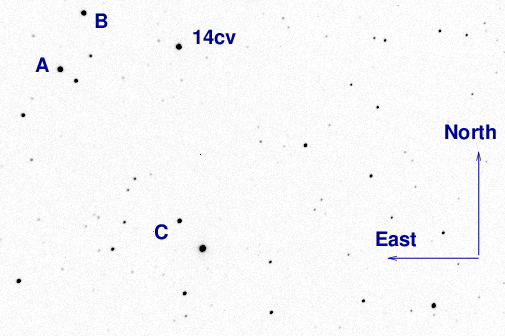
Some of the reference stars marked above have magnitudes in the UCAC4. Specifically, star "A" above is
The television camera on the finder scope shows the following when we're pointed at ASAS-14cv. North up, East left, field about 1 degree on a side.
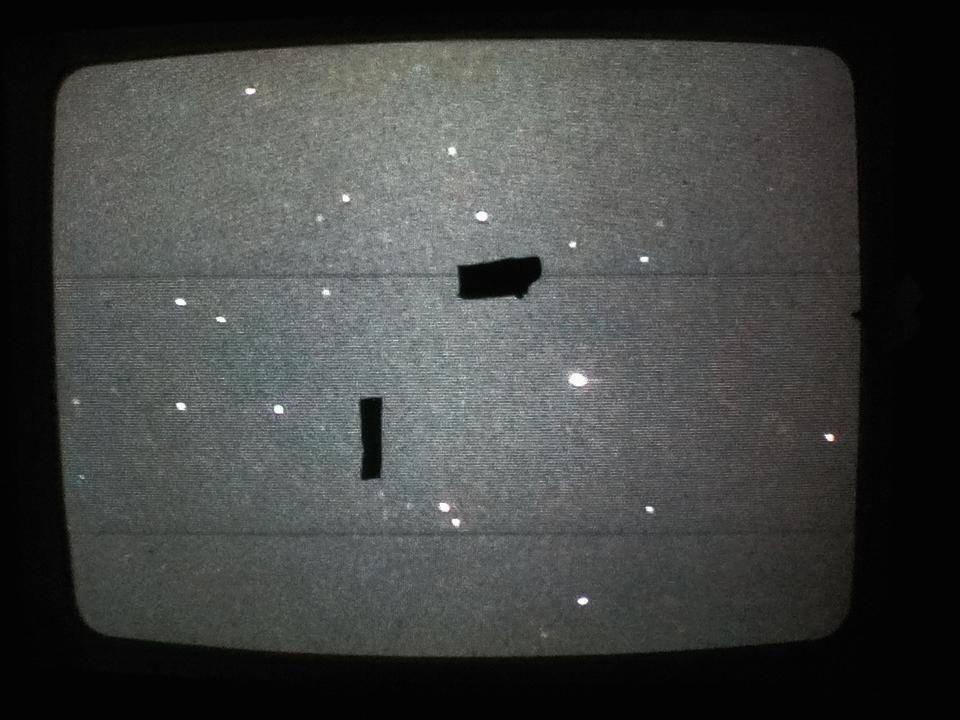
The image adjustment factor graph shows only a small and brief bump due to clouds.

Using aperture photometry with a radius of 4 pixels (radius of 7.4 arcsec), I measured the instrumental magnitudes of a number of reference stars and the target. Following the procedures outlined by Kent Honeycutt's article on inhomogeneous ensemble photometry, I used all stars available in each image to define a reference frame, and measured each star against this frame. I used the UCAC4 V-band magnitude of star "A" to convert the ensemble instrumental magnitudes to a reported "V"-band magnitude (but remember, it's a clear filter).
Sigma-vs-mag plot: the outlier is a star at the edge of the chip, not a real variable.
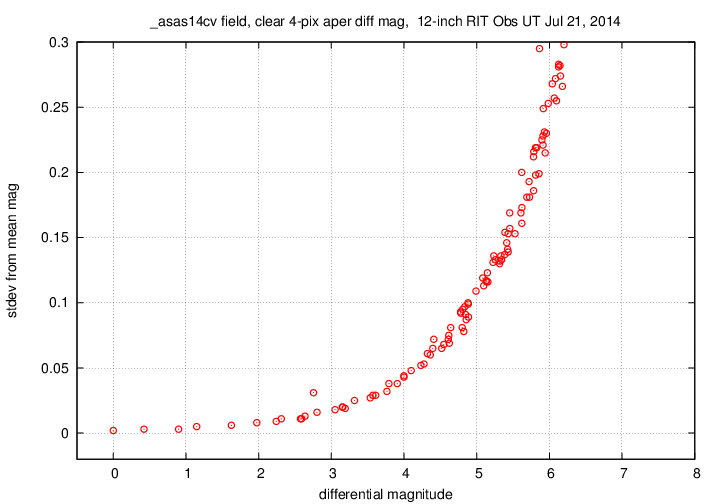
The target, shown in green, is so faint the the random scatter (about 0.14 mag) hides its variation.
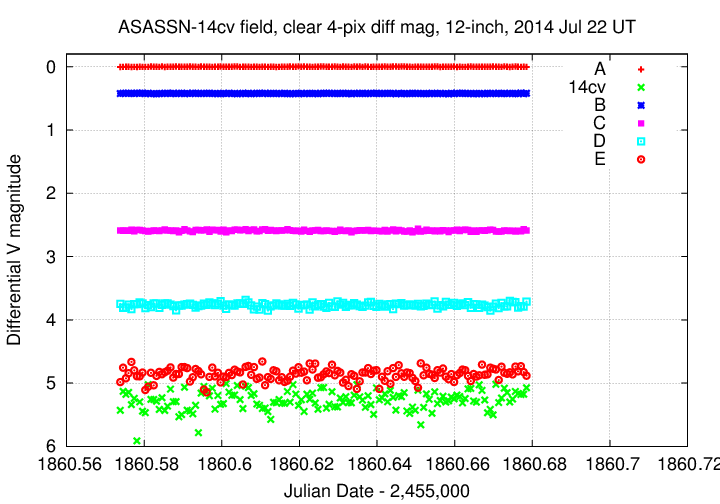
In order to try to pull out some signal from this noisy data, I co-added set of 3 consecutive images; that is, I create one image from original images 1+2+3, then another from 4+5+6, and so forth. The effective exposure time was 3x45 = 135 seconds. The results are less noisy, but the target is _still_ so noisy that it's hard to see real variation.
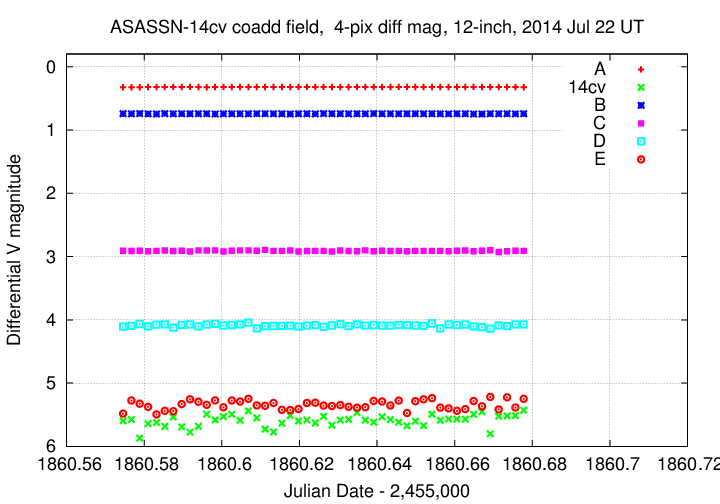
You can see my measurements of the star from the co-added images in the ASCII text file below. The first few lines are shown here:
# Measurements of ASAS_SN14cv made at RIT Obs, Jul 22, 2014 UT, # in fair conditions. # by Michael Richmond, using 12-inch Meade and SBIG ST-8E CCD. # Exposures 3x45 seconds long, no filter. # Tabulated times are midexposure (FITS header time - half exposure length) # and accurate only to +/- 3 second (??). # 'mag' is a differential magnitude based on ensemble photometry # using a circular aperture of radius 7.4 arcseconds. # which has been shifted so UCAC4 711-058151 has mag=11.518 # which is its V-band mag according to UCAC4. # # UT_day JD HJD mag uncert Jul22.07456 2456860.57456 2456860.57571 17.114 0.081 Jul22.07670 2456860.57670 2456860.57785 17.093 0.082 Jul22.07884 2456860.57884 2456860.57999 17.389 0.105
DQ Her is an old nova which now varies on a range of timescales. It's a good cataclysmic variable for long-term study, so I thought I'd try to observe it for the first time.
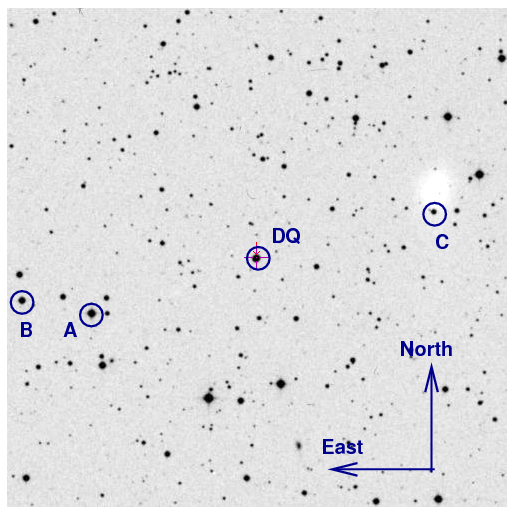
The star labelled "C" in the chart above is called 000-BCB-308 in the AAVSO chart 13554BOB, which provides these magnitudes (among others).
B = 14.392 +/- 0.013 V = 13.789 +/- 0.012
I'll use this star to set the magnitude scale of my measurements, setting my unfiltered magnitudes to be "V"-band .
The television camera on the finder scope shows the following when we're pointed at DQ Her. North up, East left, field about 1 degree on a side.
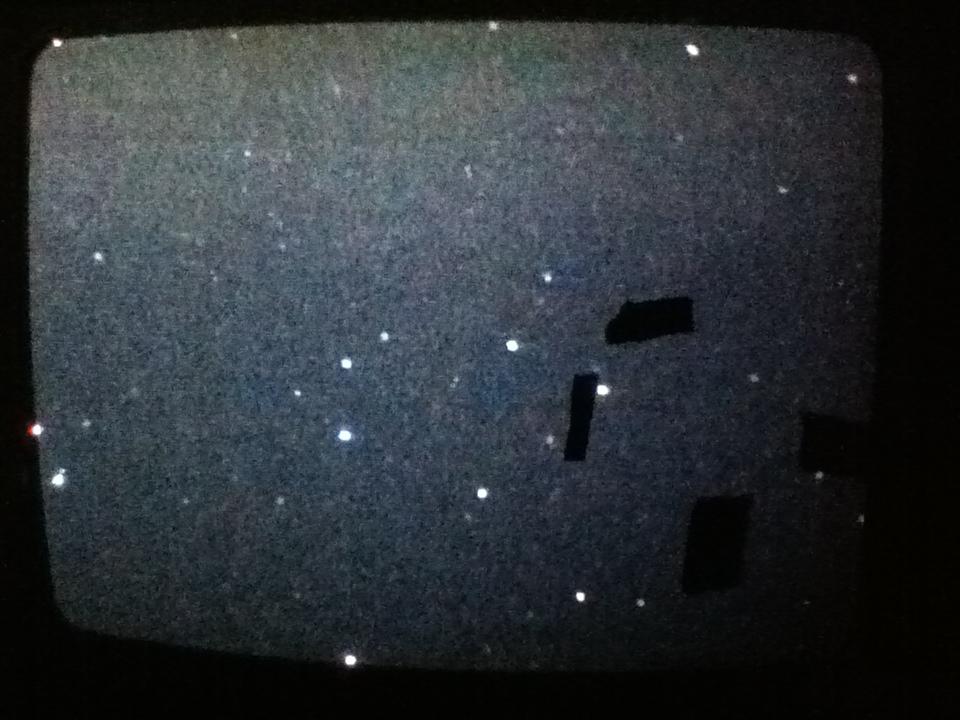
The image adjustment factor graph shows some small bumps due to clouds.
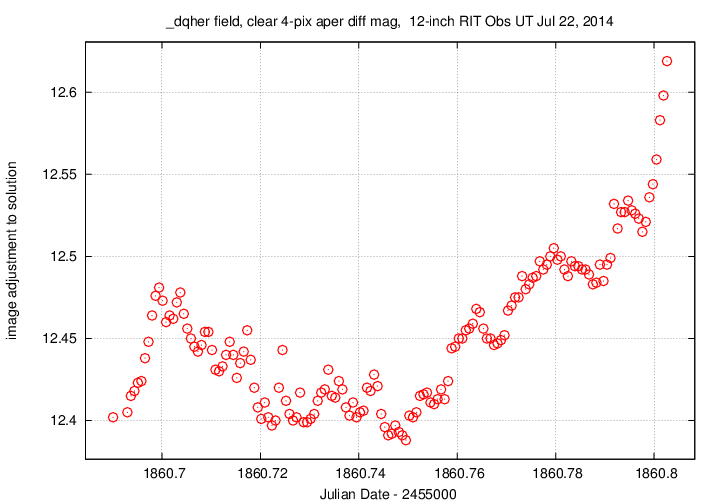
Using aperture photometry with a radius of 4 pixels (radius of 7.4 arcsec), I measured the instrumental magnitudes of a number of reference stars and the target. Following the procedures outlined by Kent Honeycutt's article on inhomogeneous ensemble photometry, I used all stars available in each image to define a reference frame, and measured each star against this frame. I used the AAVSO V-band magnitude of star "C" to convert the ensemble instrumental magnitudes to a reported "V"-band magnitude (but remember, it's a clear filter).
Sigma-vs-mag plot:

The target, shown in green, is so faint the the random scatter (about 0.14 mag) hides its variation.
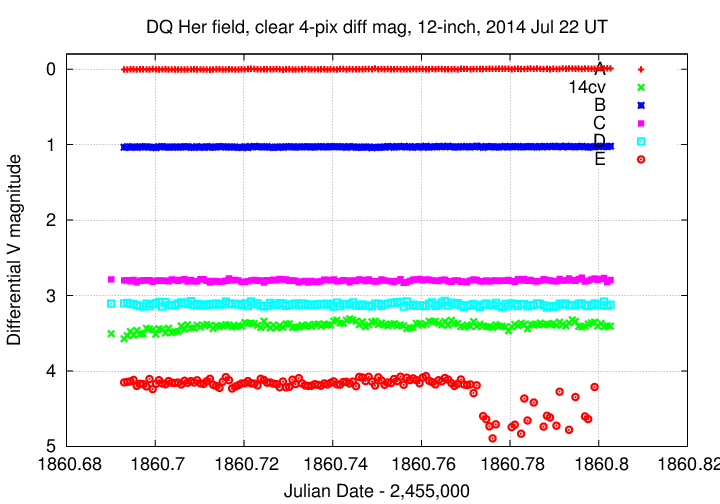
The strange light curve near the bottom, star "E", belongs to the star UCAC4 679-061168. I believe that a bad pixel on the chip is responsible for the sudden drop in apparent brightness, but I'll keep my eye on this for the future.
You can see my measurements of the star in the ASCII text file below. The first few lines are shown here:
# Measurements of DQ_Her made at RIT Obs, Jul 22, 2014 UT, # in fair conditions. # by Michael Richmond, using 12-inch Meade and SBIG ST-8E CCD. # Exposures 45 seconds long, no filter. # Tabulated times are midexposure (FITS header time - half exposure length) # and accurate only to +/- 1 second (??). # 'mag' is a differential magnitude based on ensemble photometry # using a circular aperture of radius 7.4 arcseconds. # which has been shifted so UCAC4 680-061769 has mag=13.789 # which is its V-band mag according to AAVSO chart 13554BOB. # # UT_day JD HJD mag uncert Jul22.19006 2456860.69006 2456860.69193 14.810 0.027 Jul22.19297 2456860.69297 2456860.69484 14.877 0.033 Jul22.19368 2456860.69368 2456860.69555 14.838 0.028
Last modified 7/22/2014 by MWR.